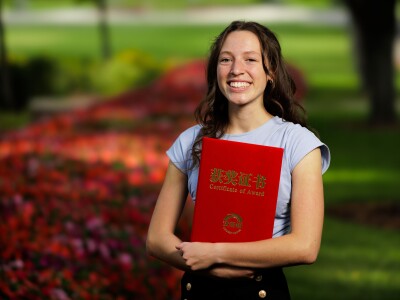Research helps runners maintain speed through barriers, water jumps

The world watched as three BYU-trained athletes competed in the 3,000-meter steeplechase at the Paris 2024 Olympics. But the running world was amazed when Kenneth Rooks won silver, bringing instant fame to Team USA and BYU steeplechasers.
Plenty of media stories have detailed the dedication and effort displayed by Rooks and fellow BYU Olympians Courtney Wayment and James Corrigan. But most people don’t know that a key to Team USA’s steeplechase success is the personalized research of BYU exercise science professor Iain Hunter.

“I’m honored to have a little part to play in helping steeplechase athletes,” said Hunter, who helps develop the strategies and techniques of elite steeplechasers nationwide. “When it’s someone you’ve got a connection with, it just adds something more when you see them accomplish their goals.”
The 3,000-meter steeplechase is an obstacle race featuring 28 barriers and seven water jumps. Mastering the event requires maintaining speed despite the barriers and water jumps on the course. Since 1997, Hunter has worked with USA Track and Field to conduct measurements on elite steeplechasers’ technique during races at the US Championships and Olympic Trials.
Hunter calculates steeplechasers’ velocity before and after landing a jump and quantifies the success of each performance based on the ratio of lost velocity. Hunter and a cadre of student researchers (he took two to the Olympic Trials this June; others helped with the analysis back at BYU) then conduct a linear regression to statistically identify which variables best predict hurdle success.
Their research finds that the speed lost when landing from a jump can be minimized by landing closer to the barrier. The common advice to accelerate before the jump actually has little impact on overall speed retention. These small adjustments to the jump take-off and landing locations can make all the difference between a good race and a medal-winning race. Just ask Rooks.
“Dr. Hunter’s research has helped me learn about certain cues that I can focus on in my hurdle or water jump form that can help me save more energy, speed, and momentum,” Rooks said. “Simple attention to detail has helped me perform to the highest level. It has been fun learning about his research and being a part of it.”
Hunter assembles personalized performance reports for Rooks, BYU’s steeplechasers and Team USA athletes. These modernized reports offer athletes an interactive website with the exact measurements of their performance, such as the speed before and after water jumps and hurdles, takeoff and landing location, and various joint angles. Each measurement is accompanied by recommendations on how to increase overall speed based on the data from hundreds of athlete’s races.
In a way, Hunter’s findings have revolutionized traditional steeplechase training — particularly for BYU’s steeplechasers whose success is arguably earning BYU the moniker of ‘Steeplechase U.’
And Hunter said the success of BYU’s humble, well-rounded athletes has had an impact that extends past the finish line. Wayment, Corrigan and Rooks have each spoken at devotionals during the Olympics, appeared on numerous podcasts, and been featured in media stories worldwide.
“All these athletes understand that running is something they do, not who they are,” Hunter said. “They realize they are children of God with families who happen to be good at racing.”




